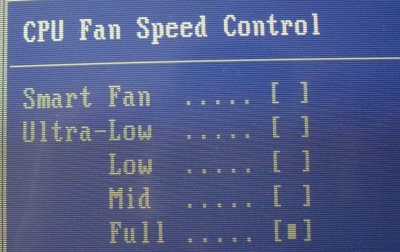BIOS
We've noticed a steady progression with XPCs' BIOSes. At first, Shuttle were adamant that voltage manipulation be left out their cubes. Recently, however, the BIOSes have resembled full-blown motherboard's. Let's take a look.
The voltage section is straightforward in every respect. The SN45 appeared to unlock a Barton CPU just fine, too. CPU ratios were available from 8x through to 23x, or you could just plump for Auto and let the board do the work. CPU Voltage is a little scary for such a confined space. 1.1v - 1.85v is all fine and well but Shuttle allow you to go up to 2v if you select the 'above 1.85v option'. We would strictly advise against anything more than 1.8v in a cube. Now that JEDEC have ratified PC3200 memory with a default voltage of 2.6v, we expected to see a little more than 2.7v here. We've noticed that 2.8 and 2.9v use is now being guaranteed by premium memory manufacturers. AGP voltage seems like a superfluous measure.

Advanced chipset features just how we like them. The CPU's FSB goes up to 250MHz in almost seamless 1MHz jumps... just the odd value is missing. The nForce2 architecture seems to allow for a number of asynchronous memory frequencies but, as always, sticking to synchronous (100%) is the sure-fire method of eliciting maximum performance. Our usual 2-6-2-2 timings were run for formal benchmarking, and this time we had no problems in running the set latencies. A previous Shuttle ATX board had refused to run at anything lower than 2-7-3-3 at the DDR400 setting. We're pleased that such a user-friendly performance manipulation screen has been included into a cube. It just goes to reinforce our premise that this is a pure performance SFF unit.

Its bias may be towards all-out performance but it also carries a whole host of features, as you can plainly see from the above picture. The MCP-T's working overtime here.

This lengthy monitoring shot carries all the information one would need to diagnose the health of this diminutive box of wonders. It's painful to see the kind of battering the 12v line takes under modest BIOS load. We'd expect full OS load to further stretch the 200w PSU. However, as long as the system runs perfectly smoothly we have very little criticism for the mini-sized power supply.

Shuttle now provide a number of different fan settings for the SN45, and each setting updates the fans' speed on the fly, i.e. toggling between the choices immediately has an impact upon the selected fans. The SN45 has a total of three usable fan headers, so noise control is certainly an issue that needed addressing.
A robust BIOS to go with a robust cube.









